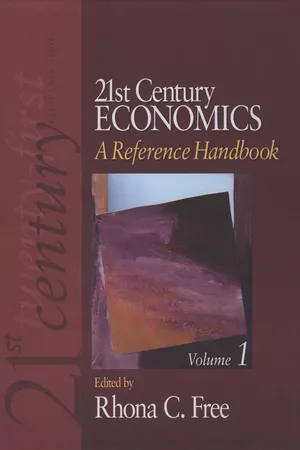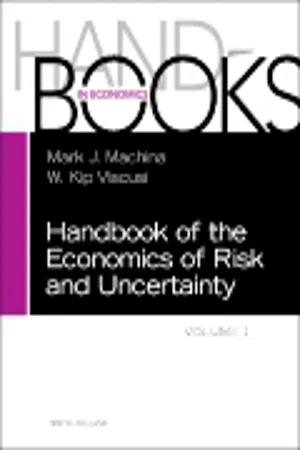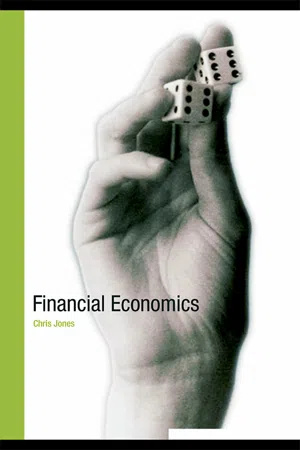Economics
Asymmetric Information
Asymmetric information refers to a situation where one party in a transaction has more or better information than the other, leading to potential imbalances and inefficiencies in the market. This can result in adverse selection and moral hazard, where one party takes advantage of the information asymmetry to the detriment of the other. In economics, addressing asymmetric information is crucial for ensuring fair and efficient markets.
Written by Perlego with AI-assistance
Related key terms
1 of 5
10 Key excerpts on "Asymmetric Information"
- Adil Akinci, ÖZER ÖZCELIK, Adil Akinci, ÖZER ÖZCELIK(Authors)
- 2021(Publication Date)
- Peter Lang Group(Publisher)
Considering the situation within the scope of economic behaviour from the perspective of Hobbes’ well-known phrase Homo homini lupus, the utility and profit that individuals aim to maxi- mize causes a conflict of economic interest in the real industry, which has, with its increasing importance, affected the financial markets. The economic indi- vidual, who considers his/her own benefit rather than that of society, causes the problem of Asymmetric Information arising from deregulation and comes to the forefront as an important cause of financial crises. 3 Asymmetric Information, Adverse Selection and Financial Crises The concept of Asymmetric Information has started to be more commonly used in economic literature after George Akerlof ’s work titled Market for ‘Lemons: Quality Uncertainty and The Market Mechanism, published in 1970. Asymmetric Information is defined as the situation in which one of the parties Asymmetric Information and Adverse Selection Problems 209 engaging in trade in markets has less information than the other party. This situation is generally thought to arise from differences in educational status, environment, personal interests and curiosity levels, and skills in modern tech- nology. The presence of Asymmetric Information results in adverse selection in the decisions to be made, and the presence of adverse selection is a factor that deteriorates the rationality of any decision (Simon, 1957: 198). Adverse selection in economic cases is a situation in which one of the parties prefers lower-quality goods or service over high-quality ones as a result of imper- fect knowledge, especially in used car markets, credit and finance markets, and the insurance industry (Akerlof, 1970: 493). Adverse selection is a commercial failure. The decisions made due to imperfect knowledge have a weak rationality, but the situation of moving away from rationality is understood when recog- nizing adverse selection.- eBook - PDF
Intermediate Microeconomics
A Tool-Building Approach
- Samiran Banerjee(Author)
- 2021(Publication Date)
- Routledge(Publisher)
Chapter 15 Asymmetric Information Information asymmetry deals with transactions where one party possesses private information, i.e., information that is not known to the other party. In this chapter, we study two canonical models covering the two basic types of information asymmetry, hidden action and hidden information , as named by Kenneth Arrow. In hidden action (or moral hazard ) models, there are two parties called a principal and an agent in a vertical relationship. The principal (henceforth assumed to be female) employs the agent (a male) to undertake some action that she cannot observe. Undertaking the action is costly, so the agent has an incentive to shirk. The principal has to write a contract based on the observable output generated by the agent so as to induce him to undertake an action that is optimal from her perspective. While she runs the risk of not compensating him enough to motivate him to work hard, he runs the risk of working hard but getting inadequately compensated because hard work is not perfectly reflected in the output generated. Thus principal-agent contracts are predicated on optimal risk-sharing between the two parties. In hidden information (or adverse selection ) models, typically there is one principal and many heterogeneous agents. Each agent knows his own type but the principal cannot distinguish one agent type from another. How-ever, she knows the distribution of types and has to design a contract so that the decisions of agents is optimal in terms of her objective. An example of this is the unit-demand bundling example from section 10.5: the tomato farmer is the principal who faces two types of agents, par-ents or singles, and has to decide whether to sell organic tomatoes only to everyone (a pooling equilibrium ), or produce both organic and regular 278 - eBook - PDF
- Rhona C. Free(Author)
- 2010(Publication Date)
- SAGE Publications, Inc(Publisher)
While Stigler's (1961) paper was a breakthrough that gave birth to a new field in economics, it treated infor-mation in very much the same way that the economists were treating other goods. Information, however, is dif-ferent in many respects. It is these differences, and infor-mation asymmetry in particular, that will be the focus of our attention. 729 730 · ECONOMIC ANALYSES OF ISSUES AND MARKETS Information Asymmetry The Problem of Asymmetry Information is valuable, and its value is often deter-mined by the number of people who know it. The fact that some people know more than others is referred to as infor-mation asymmetry. The examples of asymmetry are numerous: A job applicant knows more about his or her abilities and work ethics than the potential employer, an entrepreneur seeking a loan from the bank knows more about the viability of his or her business than the loan offi-cer, and a person buying health insurance knows more about his or her health than the insurance company. Asymmetry is a departure from the model of perfect mar-kets, and it creates challenges and problems. While the problems of information asymmetry had been realized by early economists, Akerlof (1970) was the first to rigorously analyze the problem of private informa-tion. He showed that information asymmetry is crucial to understanding how markets operate. Consider the market for used cars, which is the example discussed in Akerlof (1970). Assume that a car can be of either good or bad quality with equal probability (Ά) —that is, there are as many good cars as there are bad cars. Further assume that for the sellers, a good car is worth $800 and a bad car is worth $50. For potential buyers, on the other hand, a good car is worth $1,000 and a bad car is worth $100. What is the equilibrium clearing price in this market? As it turns out, the answer depends on who knows what. First, consider the case when neither sellers nor buy-ers can differentiate between good and bad cars. - Mark Machina, W. Kip Viscusi(Authors)
- 2013(Publication Date)
- North Holland(Publisher)
The quintessential example of this is a seller who knows the quality of the good she seeks to sell. Because she cannot commit fully to not deceive her counter party, inefficiencies arise. The last section examines the problems that arise if the asymmetry of information arises endogenously, because one party’s prior-to-trade actions provide him or her payoff-relevant information. Keywords Tariff Construction, Economic Mechanism, Revelation Principle, Spence-Mirrlees Condition, Direct Revelation Mechanism, Linear Pricing, Insurance Theory, Economic Trade Theory, Information Asymmetry 6 Contents 6.1 Introduction 264 6.2 Exogenous Asymmetries of Information at Time of Contracting: Informed Buyer 269 6.3 Two-Sided Asymmetric Information 293 6.4 Exogenous Asymmetries of Information at Time of Contracting: Informed Seller 313 6.5 Endogenous Asymmetries of Information at Time of Contracting 340 6.6 Final Thoughts 365 Appendix 366 References 382 Benjamin E. Hermalin 264 6.1 INTRODUCTION Almost every market transaction is plagued by one party, at least, being ignorant of pertinent information. In some instances, both parties are ignorant of the same thing: neither farmer nor commercial granary know what the weather will be over the com-ing season when agreeing to a futures contract. In many instances, however, while one party is ignorant, the other knows the relevant information (or at least has better information): you know your willingness to pay for items in a shop, but the shopkeeper does not; you know the reliability of the used car you are selling, a potential buyer does not; and so on. Although instances of common ignorance are not without interest—they, for exam-ple, are critical to understanding insurance and financial markets—such markets can often be analyzed using “textbook” methods once the situation is reformulated in terms of state-contingent commodities (see, e.g., Section 6.2.2.1 infra ).- eBook - PDF
Economics
A Contemporary Introduction
- William A. McEachern(Author)
- 2016(Publication Date)
- Cengage Learning EMEA(Publisher)
14-3d Coping With Asymmetric Information There are ways of reducing the consequences of Asymmetric Information. An incentive structure or an information-revealing system can be developed to reduce the problems associated with the lopsided availability of information. For example, all states now have “lemon laws” that offer compensation to buyers of new or used cars that turn out to be lemons. Used-car dealers may also offer warranties to reduce the buyer’s risk of getting stuck with a lemon. For example, some sellers offer money-back guarantees, though consumers moral hazard A situation in which one party, as a result of a contract, has an incentive to shirk responsibilities in a way that harms the other party to the contract 15. Liran Einav and Amy Finkelstein, “Selection in Insurance Markets: Theory and Empirics in Pictures,” Journal of Economic Perspectives, 25 (Winter 2011): 115–138. 16. David Autor, Mark Duggan, and Jonathan Gruber, “Moral Hazard and Claims Deterrence in Private Disability Insurance,” American Economic Journal: Applied Economics, 6 (October 2014): 110–141. Copyright 2017 Cengage Learning. All Rights Reserved. May not be copied, scanned, or duplicated, in whole or in part. Due to electronic rights, some third party content may be suppressed from the eBook and/or eChapter(s). Editorial review has deemed that any suppressed content does not materially affect the overall learning experience. Cengage Learning reserves the right to remove additional content at any time if subsequent rights restrictions require it. Chapter 14 Transaction Costs, Asymmetric Information, and Behavioral Economics 325 are usually wary of such offers. 17 Most auto-repair garages provide written estimates before a job is done, and many return the defective parts to the customer as evidence that the repair was necessary and was carried out. People often get multiple estimates for major repairs. - eBook - PDF
- John Leach(Author)
- 2003(Publication Date)
- Cambridge University Press(Publisher)
Find the parameters of this contract. 22 Other Examples of Asymmetric Information This chapter discusses three areas in which Asymmetric Information has substantial “real world” applications. 22.1 HEALTH CARE AND HEALTH CARE INSURANCE There are many instances in which problems of adverse selection or moral hazard are re-solved (or ameliorated) without government intervention. However, one sector in which these problems have been particularly profound, and have consequently prompted gov-ernment intervention, is the provision of health care and health insurance. In Canada, as in many European countries, universal health care insurance and many forms of health care are provided by the government. In the United States, there is a smaller but nevertheless significant degree of government involvement. Let’s look at the problems and their solutions. 1 22.1.1 Adverse Selection An insurance company is offering actuarially fair insurance if, in an average year, the premiums paid by the policy-holders are just equal to the payments made to the policy-holders. Risk-averse people would always accept actuarially fair insurance, and for the remainder of this section, we shall imagine that everyone is risk-averse. Suppose that a group of companies offered health care insurance which would be actuarially fair if it were accepted by all of the residents of a region. Would everyone living in the region actually accept the insurance? Would the companies have an incentive to alter the terms on which they offer insurance? 2 1 The implications of Asymmetric Information for medical care were first studied by Arrow [5]. Research in this area, and in the study of insurance generally, tends to be abstract and is not easily accessed by those without a substantial grasp of mathematics. - eBook - PDF
Microeconomics
A Contemporary Introduction
- William A. McEachern(Author)
- 2016(Publication Date)
- Cengage Learning EMEA(Publisher)
14-3d Coping With Asymmetric Information There are ways of reducing the consequences of Asymmetric Information. An incentive structure or an information-revealing system can be developed to reduce the problems associated with the lopsided availability of information. For example, all states now have “lemon laws” that offer compensation to buyers of new or used cars that turn out to be lemons. Used-car dealers may also offer warranties to reduce the buyer’s risk of getting stuck with a lemon. For example, some sellers offer money-back guarantees, though consumers moral hazard A situation in which one party, as a result of a contract, has an incentive to shirk responsibilities in a way that harms the other party to the contract 15. Liran Einav and Amy Finkelstein, “Selection in Insurance Markets: Theory and Empirics in Pictures,” Journal of Economic Perspectives , 25 (Winter 2011): 115–138. 16. David Autor, Mark Duggan, and Jonathan Gruber, “Moral Hazard and Claims Deterrence in Private Disability Insurance,” American Economic Journal: Applied Economics , 6 (October 2014): 110–141. Copyright 2017 Cengage Learning. All Rights Reserved. May not be copied, scanned, or duplicated, in whole or in part. Due to electronic rights, some third party content may be suppressed from the eBook and/or eChapter(s). Editorial review has deemed that any suppressed content does not materially affect the overall learning experience. Cengage Learning reserves the right to remove additional content at any time if subsequent rights restrictions require it. Chapter 14 Transaction Costs, Asymmetric Information, and Behavioral Economics 325 are usually wary of such offers. 17 Most auto-repair garages provide written estimates before a job is done, and many return the defective parts to the customer as evidence that the repair was necessary and was carried out. People often get multiple estimates for major repairs. - eBook - ePub
- Chris Jones(Author)
- 2008(Publication Date)
- Routledge(Publisher)
This is referred to as the mutuality principle that holds in all the consumption-based asset pricing models examined earlier in Chapter 4. We look at insurance with common (symmetric) information in Section 5.1 and then extend the analysis by introducing Asymmetric Information in Section 5.2. Consumers will fully insure against individual risk in a frictionless competitive equilibrium when traders have common information and state-independent preferences. We use this as a benchmark to identify the effects of trading costs and Asymmetric Information. Consumers choose not to fully insure when trading costs raise the price of insurance above the probability of incurring losses. When they are minimum necessary costs of trade the competitive equilibrium outcome is Pareto efficient, where expected security returns rise to compensate consumers for the cost of eliminating individual risk from their consumption expenditure. A number of government policies, including price stabilization schemes and publicly funded insurance, are justified as ways to overcome the effects of Asymmetric Information on private insurance. Moral hazard and adverse selection are the most widely cited problems. With moral hazard consumers have the ability to reduce their individual risk by undertaking costly self-protection. Whenever marginal effort, which cannot be observed by insurers, is not reflected in the price consumers pay for insurance, they less than fully insure. Adverse selection occurs when there are consumers with different probabilities of incurring losses that insurers cannot costlessly identify and separate. Low-risk types suffer from highrisk types buying low-risk policies. This imposes externalities on low-risk consumers. At one extreme high-risk types may prove too big a problem for the existence of a private insurance market. These are the most common reasons cited for incomplete insurance markets - eBook - PDF
How to Regulate
A Guide for Policymakers
- Thomas A. Lambert(Author)
- 2017(Publication Date)
- Cambridge University Press(Publisher)
There probably are. The problem is instead “information asymmetry.” Compared to the insureds buying its product, the bad grade insurer would know less about buyers’ characteristics (e.g., their native intelligence) and post-purchase behavior (e.g., their exam preparation efforts). As we’ll soon see, when buyer and seller have significantly different levels of information about each other’s offerings and conduct, markets may not emerge even for products and services that create greater value than they cost to produce and sell. symptoms/disease As the foregoing discussion suggests, the primary symptom of information asymmetry between buyers and sellers is product unavailability: Goods and services that people would like to have are not made available even when they cost less to produce than the value they generate. Understanding why this unhappy situation emerges requires examining more closely what happens when the parties to a transaction face an informational imbalance. As it turns out, the general Asymmetric Information disease manifests itself in two more specific maladies. To understand the first malady, consider a classic market in which buyers and sellers have significantly different levels of information about the thing being sold: the used car market. It’s hard for most used car buyers to tell the difference between a reliable used car (a “peach”) and one with latent mechanical problems (a “lemon”). Lemons often look like good cars even though they’re mechanical disasters. Used car sellers, on the other hand, usually have a good sense of what their car is really worth. They know if it’s really a lemon or a peach or something in between (a kumquat?). 186 Information Asymmetry So suppose a community contains 100 peach-looking used cars ranging in value from $10,000 at the high end down to $100. Suppose further that each car’s value is unique and that the values are evenly distributed throughout the range (e.g., $10,000, $9,900, $9,800, . . . $300, $200, $100). - eBook - PDF
Information Markets
A Strategic Guideline for the I-Commerce
- Frank Linde, Wolfgang G. Stock(Authors)
- 2011(Publication Date)
- De Gruyter Saur(Publisher)
These initial considerations already show what behaviors a company can use in order to make viable offers on an in-formation market despite the presence of economic adversity. Such measures on the part of companies to pointedly offer quality information is called Signaling. The whole of Chapter 22 is devoted to this subject. 3.3.5 Information Asymmetries Before and After Completion of a Contract: Adverse Selection and Moral Hazard For the question of whether information asymmetries occur before or after the signing of a contract, we can distinguish between two kinds of contracts: those that are completed as purchasing agreements according to §§ 433 et seq. of the 48 Economic Particularities of Information Goods German Civil Code (Bürgerliches Gesetzbuch, BGB), or–and this will be of sig-nificance in the following–as contracts for services according to §§ 631 et seq. BGB, in which the provider performs a service (e.g. a survey or a Web design with animations) for a fee. Due to the relatively unpronounced search qualities, information asymmetries prior to the signing of a contract give rise to the problem of Adverse Selection. Customers can only really comprehensively inform themselves about the quality of an information product if they have actually received the information (informa-tion paradox). The providers, in turn, have no interest in reducing this information asymmetry by comprehensively disclosing the information. Even if the informa-tion provider is prepared to disclose parts of the information prior to purchase, the problem still remains that the demander cannot necessarily assess the quality. De-pending on his level of knowledge, he may be able to assess the experience quali-ties, e.g. whether information about a company’s business performance is plausi-ble. Assessing the credence qualities, however, is–as has been seen on the exam-ple of the market research study–impossible even to the expert, or at the very least connected to prohibitive costs.
Index pages curate the most relevant extracts from our library of academic textbooks. They’ve been created using an in-house natural language model (NLM), each adding context and meaning to key research topics.









